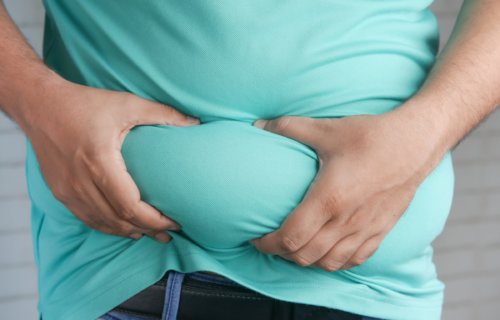OSLO, Norway — Need another reason to lose some weight? A new study finds that carrying a pot belly or muffin top during middle age can more than double the risk of becoming frail as an older adult. Many people think of frailty as a wasting condition, but the researchers from the University of Oslo say that keeping trim throughout life is a good way of reducing weakness later in life.
Study authors looked at 4,500 people over the age of 45 who were monitored for an average of 21 years as part of the Tromsø Study. They defined pre-frailty by at least two signs and frailty as at least three of five signs of the condition. Specifically, these include unintentional weight loss, exhaustion, weak grip strength, slow walking speed, and low physical activity levels. People with the condition are vulnerable to falls, disability, hospital admission, reduced quality of life, and death.
Study authors were looking to add to the evidence that overweight middle-aged people had a higher risk of frailty later on because being obese aggravates the decline in muscle strength, aerobic capacity, and physical function. However, there have been few studies tracking weight changes and frailty risk over the long term.
The study, published in the journal BMJ Open, concludes that those with a high BMI (body mass index) in 1994 were two and a half times more likely to be frail in 2015. The study authors add that carrying far too much weight, including a midriff bulge, heightens the risk of physical frailty in old age.
“In the context where the population is rapidly ageing and the obesity epidemic is rising, growing evidence recognizes the subgroup of ‘fat and frail’ older individuals in contrast to viewing frailty only as a wasting disorder,” study authors write in a media release.
They add that their study “highlights the importance of routinely assessing and maintaining optimal BMI and [waist circumference] throughout adulthood to lower the risk of frailty in older age.”
Who is at the highest risk for frailty?
The team studied whether general (BMI) and abdominal (waist circumference) obesity separately and jointly, might affect the risk of pre-frailty or frailty. The average age at the beginning of the study was 51 years-old. The team considered a BMI of less than 18.5 as underweight, 18.5-24.9 as normal, 25–29.9 as overweight, and 30 and above as obese.
By 2015-16, 28 percent of participants were pre-frail, one percent were frail, and 70.5 percent were still strong. In all, nearly 51 percent of those who were strong and 55 percent of those categorized as pre-frail were women.
While participants in both the strong and pre-frail and frail groups put on weight and expanded their waistlines during the monitoring period, there were higher proportions of participants with normal BMIs and waistlines at the start of the monitoring period in the strong group. Conditions, such as diabetes and potentially influential factors, including drinking and smoking, education, marital status, and social support, and physical activity levels differed significantly between the strong and pre-frail and frail groups and were accounted for in the analysis.
Overall, those who were obese in 1994, assessed by BMI alone, were nearly 2.5 times more likely to be pre-frail or frail at the end of the monitoring period than those with a normal BMI. Those who started off with a normal BMI but moderately-high waist circumference, or who were overweight but had a normal waistline, weren’t significantly more likely to be pre-frail or frail at the end of the monitoring period. However, those who were both obese and who had a moderately-high waist circumference at the start of the monitoring period were more likely to be frail.
Higher odds of pre-frailty or frailty were also observed among those who put on weight and among those whose waistlines expanded than in those whose weight and waistlines remained the same throughout.
Why does weight gain lead to frailty?
While the findings echo those of previous long-term studies, this is an observational study, which didn’t track potentially influential changes in lifestyle, diet, and friendship networks that might have occurred during the monitoring period. Researchers also point out that the findings were still significant for participants with baseline obesity and higher waist circumference when people over 60 were excluded from the analysis. Additionally, few underweight people were included in the study.
There are some plausible biological explanations for the findings, the researchers suggest. These include the increased inflammatory capacity of fat cells and their infiltration into muscle cells, both of which likely boost naturally occurring age related decline in muscle mass and strength, so heightening the risk of frailty.
South West News Service writer Jim Leffman contributed to this report.

